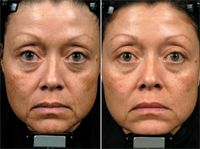- General Dermatology
- Eczema
- Chronic Hand Eczema
- Alopecia
- Aesthetics
- Vitiligo
- COVID-19
- Actinic Keratosis
- Precision Medicine and Biologics
- Rare Disease
- Wound Care
- Rosacea
- Psoriasis
- Psoriatic Arthritis
- Atopic Dermatitis
- Melasma
- NP and PA
- Skin Cancer
- Hidradenitis Suppurativa
- Drug Watch
- Pigmentary Disorders
- Acne
- Pediatric Dermatology
- Practice Management
- Prurigo Nodularis
Article
Blocking out rays: Once-a-day topical serum protects skin
The orthodox use of strong sunscreens is largely effective in blocking harmful ultraviolet (UV) rays. However, this protective measure is not 100 percent successful. Recent research finds that the once-a-day application of a novel topical serum containing antioxidants not only helps protect the skin from harmful UV rays, it also improves the visible signs of photodamage.

Key Points
San Francisco - The daily application of a novel serum containing a combination of antioxidants improves several aspects of photodamaged skin, including fine lines, wrinkles, dyspigmentations and skin texture. According to one expert, this topical once-a-day treatment not only helps protect the skin from ultraviolet (UV)-induced photodamage, but also improves the aging effects of UV radiation.
"Overexposure to UV radiation will inevitably cause photodamage and accelerate skin aging. There are many products and measures that can be taken to mitigate the effects of UV, and one of the cornerstones of UV protection is the use of sunscreens.

Dr. Oresajo and his team recently completed a study evaluating the efficacy and tolerance of the unique topical combination of antioxidants containing vitamin C, ferulic acid and phloretin (SkinCeuticals, L'Oréal) on photodamaged skin. The team presented their findings in an electronic poster at the American Academy of Dermatology's annual meeting in March.
CLINICAL STUDY

Objective and subjective irritation parameters were evaluated, and Chroma Meter (Minolta) measurements of the same selected hyperpigmented lesion of the face - as well as Cutometer (CK Electronic) measurements of the skin's visco-elastic properties - were taken.
Additionally, silicone replicas of the periocular wrinkles were taken at each study visit, and digital images of the face were taken to evaluate efficacy.
A clinician graded and assessed the improvements of the visible aspects of photodamaged skin at baseline and weeks four, eight, 12, 18 and 24.
RESULTS
Results showed that statistically significant improvements could be seen throughout the study when compared to baseline for all of the clinical assessment parameters.
Results of the Chroma Meter analyses showed an increase in skin brightness/lightness at each follow-up assessment, and a reduction in skin pigmentation at week 18. The silicone replicas showed an improvement in skin texture.
By week eight, more than 79 percent of participants were satisfied with the overall appearance of their skin, more than 77 percent felt that the topical product reduced the appearance of fine lines and wrinkles and more than 62 percent saw a reduction in brown spots and dyspigmentations.
Though SkinCeuticals contains high concentrations of vitamin C, ferulic acid and phloretin, the topical serum was well-tolerated by volunteers throughout the study, and none of the participants showed any significant increases in erythema, edema, scaling/peeling, burning, itching or tingling.





